Journal of Hotel and Business Management
Open Access
ISSN: 2169-0286
ISSN: 2169-0286
Research Article - (2023)Volume 12, Issue 3
Mangalore is an important port city in the South Indian state of Karnataka. With its Arabian coastline, it is home to a variety of cuisines. Tuluva cuisine forms a part of the Mangalorean cuisine which comprises cuisines like Udupi as well as cuisines of different Mangalorean communities like the Hindus, Christians and Muslims with the Tuluva ethnic group forming the majority of the population.
Tuluva cuisine comprises some unique dishes such as chicken sukka, Neer dosa, Kori rotti, patrode, kadubu, bangude pulimunchi, chicken ghee roast and many more which are found to be prepared predominantly in this region of the country. It's being liked now by people all over the country. As a result, there is an increase in the number of Mangalorean based restaurants sprouting all over Karnataka and the country as well. Hence, it is difficult to give the exact number of such restaurants as it's an unorganized sector given the vast street food sections which are known worldwide.
The present study was conducted to understand the acceptance of the people towards these traditional Tuluva cuisines. As preparation of these traditional foods is time consuming and with an increased surge in the number of working class women as well as increased growth of convenience foods, people prefer consumption of these food items at restaurants/hotels. Hence, this study also focuses on understanding the opinion of people going to restaurants serving authentic Tuluva dishes. The findings of the study revealed that the major portion of the customers visiting the restaurant opted for traditional Tuluva cuisine over other food items offered by the restaurant; also the authenticity of the traditional foods played an idle role in the acceptance of these foods.
Tuluva cuisine; Mangalore cuisine; Dakshina Kannada; Authentic; Population
Tulu Nadu, which is also called 'Kudla' or 'Parashurama Srishti', by the locals or renowned as Mangalore forms an integral part of the Indian coastline. The Tulu speaking people known as 'Tuluvas' people whose native language is Tulu form the predominant cultural group occupying this region. It is categorized under the Dakshina Kannada district which forms the second major district of Karnataka state, with its headquarters in the port city of Mangalore. It is the only district in Karnataka to have all four modes of transport i.e., through road, railway, water and air. It is known as the 'cradle of banking in India'. Mangalore city is named after the very famous Hindu temple called the "Mangaladevi temple", which is dedicated to the Hindu goddess 'Shakti', meaning power [1].
Mangalore city is known for its multiculturalism, it is a locale of blended societies and ways of life. Individuals from various networks and adjoining states have moved here for business, occupations, instruction and significantly more. Subsequently, the city is a reformist in culture. Hence, the different cultures, traditions and religions affect Tulu Nadu cuisine greatly. Mangalorean food is also affected by South Indian cooking, with a few foods being novel to the different networks of the area. Coconut and curry leaves are normal fixings to most Mangalorean curry, as are ginger, garlic and stew. The major portion of the Tuluvas is non-vegetarians. Since it's a coastal town, seafood forms the staple diet of most people. Mangalorean fish curry is a well-known dish all across Karnataka.
The notable Tuluva dishes include kori rotti which is dry rice flakes plunged in gravy, bangude pulimunchi (silver-grey mackerels), beeja manoli upkari, neer dosa (fancy rice crepes), boothai gassi, kadubu and patrode. The konkani speaking people's diet will consist of Daali thoy beebeupkari (prepared using cashew), avnas ambe sasam, Kadgi chakko, paagila podi and chana gashi. Mangalorean catholic’s sanna dukra maas (Sanna idli fermented with drink or yeast; dukra maas pork), pork bafat, sorpotel and the mutton biryani of the muslims are notable dishes. Pickles, happala, sandige and puli munchi are distinctive to Mangaluru. Khali/Toddy is country alcohol obtained from coconut sap and is well known. Mangalorean food is notable for its unmistakable flavor. Tuluva cuisines are spicy and ground coconut or coconut milk forms an integral part of cooking. Rice is the staple cereal of the Mangalorean diet [2].
Objective
The objective of this study is:
• To understand the preference and acceptance of the traditional Tuluva cuisines among the present-day generation.
• Role of restaurants in maintaining the legacy of these traditional Tuluva dishes.
• An attempt to understand why people visit restaurants that serve authentic Tuluva cuisine.
Popular Tuluva dishes
Mangalorean chicken sukka, locally called 'Kori Sukka/Kori Ajadina', is a dish native to Tulu Nadu. The word 'sukka' is derived from the Hindi word 'Sukha', meaning dry. This dish can be prepared either as a dry item or in a semi dry state. It is prepared in different regions of the country using various variations.
Neer dosa: Neer meaning water and dosas are nothing but pancakes. Neer dosa is a very thin type of pancake/dosa prepared in Tulu Nadu using simple rice batter usually served with chutneys, sambars or any other non-vegetarian gravy.
Kori rotti: Kori is chicken and rotti is similar to flat bread, it is prepared by using parboiled rice. This dish comprises of pouring the flavorful and spicy chicken curry all over the rotti and allowing the curry to step into it.
Goli baje is a fermented product made from maida or allpurpose flour. It is also called Mangalorean bajji or bonda and is served as a tea time snack.
Bangude pulimunchi and Bangude gassi are both dishes prepared using mackerel fish. Bangude is the name given to mackerel in Tulu. Pulimunchi is a semi dry, spicy dish prepared using the mackerel without the addition of coconut whereas gassi is gravy prepared with the help of coconut. Both these dishes are unique to Tulu Nadu.
Boothai gassi: Boothai is the local name given to sardines in Tulu Nadu. Boothai gassi is nothing but a spicy coconut based curry prepared using sardine.
Chicken ghee roast is another unique dish prepared by cooking the chicken in a liberal amount of ghee to incorporate its authentic flavor into the dish. It is a spicy, dry product that is usually served along with neer dosa. Boiled rice forms the staple food item and forms a center piece of every meal. It is commonly consumed with sambar (a combination of lentils and vegetables prepared in the form of a curry) or rasam/saaru (savory, sweet, sour stock prepared using kokum, tamarind, tomato or dried mango juice as base) together with palya (a dish prepared by sauteing diced vegetables along with spices and seasonings and grated coconut) as accompaniment. Apart from this 'gassi', gravies of meat origin such as chicken, mutton or fish is served in combination with rice. Non-vegetarians usually prefer fish curries to be served alongside rice since fishes like sardines, silver fish are cheaper. Happla, a flatbread prepared from dough of black gram and sandige, prepared using rice flour or any cereal, which are deep fat fried, are commonly served along with palya as an accompaniment. Curds as such, lassi or buttermilk are consumed as a refreshing drink. Chutneys also form an important part of the diet; they are commonly served with dosas and idlis. The specialty of chutneys served here is that even seafood based chutneys are also prepared which include chutneys prepared using coconut and dried shrimps or fish [3].
The guests visiting the restaurant were asked to answer a survey. This was done for a period of two months during which 350 responses were recorded. The restaurant chosen for this purpose was the one that serves a variety of authentic traditional Tuluva cuisine. It is located in Valencia, Kankanady and Mangalore and was chosen due to the crowd that lived in and around the area. It includes people from various walks of life and of different castes, religions and economic statuses. The closely located educational institutes such as schools, colleges, hospitals and other working setups including corporate setups led to the inflow of a variety of people visiting the restaurant.
The restaurant serves a variety of milkshakes, mocktails, cocktails, wine and other spirits. A variety of appetizers and soups are also served. Seafood holds a special place on the menu. The Non-vegetarian menu consists of all specialty Tuluva cuisine, which includes chicken sukka, neer dosa, kori roti, uppu munchi (chicken or mutton), kadi patta (chicken or mutton), urval, ghee roast, various fish gassi, tawa fry and masala (based on the availabitiy of type of fish), calamari in the form of soup, chilli or dry masala, shrimps tawa fry or masala, mussels sukha, crabs curry or sukka and fish thali, which is commonly served with Mackerel fish is also available. Sanna (fluffy idli prepared by fermentation with yeast or toddy) along with dukra maas (pork in the form of bafat) is also available and is mostly consumed by the Mangalorean catholics. Mutton biryani, a favorite among Muslims is also served here. The pricing of the dishes varied from 250 rupees to 400 rupees on an average; whereas the pricing of the fishes depended on the type of fish and as per catch, the large fishes such as pomfret, kingfish and so on prices are higher when compared to the smaller and more common fishes such as sardines, mackerel and silverfish [4].
A questionnaire was prepared and presented to around 350 guests visiting the restaurant. The questionnaire consisted of questions related to the background of the respondent, quality of the food served, the ambiance of the restaurant, value for money, authenticity of the traditional dishes served, preference for traditional dishes over other dishes served and his/her overall experience.
Age group
This study was conducted in one of the well-known restaurants in Mangalore, located in Valencia, named 'martin's multi cuisine restobar'. The survey done helps us to understand the popularity of the Tuluva cuisine among the Mangaloreans, the authenticity of the traditional dishes served and the experience of the guests who visit the restaurant which helps us to understand the mentality and expectations of the consumers better. The restaurant has guests ranging from youngsters, family crowd and elderly people, which helps us to cover a wide array of age groups [5].
The first age group 16-25 age, includes students mostly and newly joined working professionals, this generation mostly prefers fast food or junk food to satisfy their hunger. Apart from this even time constraints act as a deciding factor in food selection. This group includes youngsters staying in hostels or paying guests to visit the restaurant to try out and experience authentic Tuluva cuisine. Mainly the age group between 26-39 consists of young adults along with middle age people who are working professionals and work throughout the week and prefer to eat a normal meal such as South Indian Thali, on a daily basis since its budgeted and prefer to go to more aesthetic places on weekends to enjoy the authentic meal along with family or friends [6-8]. The older adults comprising of 40-59 years of age prefer authentic Mangalorean cuisine and turn towards the consumption of Tuluva cuisine the restaurant offers. The elderly also prefer traditional Tuluva cuisine which acts as comfort food for them. It is also observed that the Tuluva delicacy is not only preferred by Tulu speaking community but also by different communities because of the flavors, simplicity and variety in preparations. The restaurant maintains the authenticity and originality of the traditional Tulunadu cuisine while considering all the factors that attract all the group clientele to visit and experience the best authentic meals (Table 1 and Figure 1).
| Age (in years) | 16-25 | 26-39 | 40-59 | 60 and above |
|---|---|---|---|---|
| Total Number | 96 | 132 | 71 | 51 |
| Percentage (%) | 27.42 | 37.71 | 20.28 | 14.57 |
Table 1: Age group of respondents.
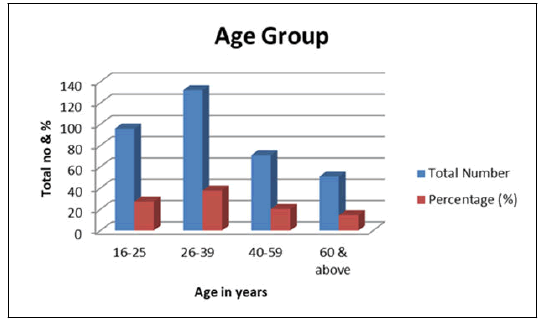
Figure 1: Age group of respondents
Frequency of visiting
It was observed that the number of people regularly eating at the restaurant was less compared to the people who visit the restaurant on a weekly or fortnightly basis. The frequent visits to the restaurants were mostly by the young adults belonging to the age group of 26-39 years. The college going students visited less often when compared to the young adults due the budget constraints whereas the older adults and elderly visit the restaurant monthly or occasionally due to health related factors or eating habits about the consumption of home-made food on regular basis and opt to eat out as a reason for a family outing or during some special occasion such as birthdays or anniversaries and so on. It was also observed that the families belonging to socioeconomically well to do backgrounds ate at the restaurant more frequently than the families belonging to low income or middle classes (Table 2 and Figure 2) [9-11].
| Frequency | Regularly/Daily | Weekly | Fortnightly | Monthly | Occasionally |
|---|---|---|---|---|---|
| Number | 28 | 37 | 69 | 118 | 98 |
| Percentage (%) | 8 | 10.57 | 19.71 | 33.71 | 28 |
Table 2: Frequency of respondents in visiting the restaurant.
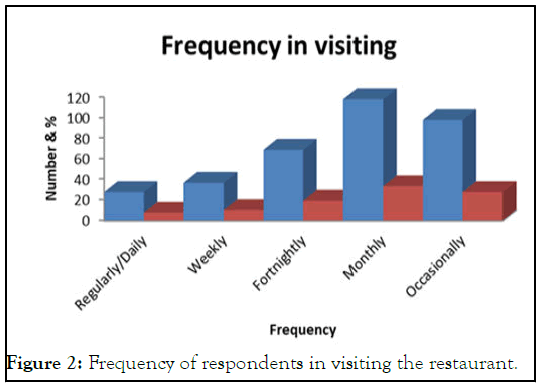
Figure 2: Frequency of respondents in visiting the restaurant.
Quality
The quality attribute is a vital component in the overall acceptability of any cuisine being served at a restaurant, particularly when it comes to specialty food (Table 3 and Figure 3). The people were asked to rate the menu set, the authenticity of the food being served, the quality maintained and the preparation as well as presentation of food. From the above table, it is clear that the food offered by the restaurant is remarkable. The restaurant maintains high quality standards, serving authentic Tuluva cuisine without a doubt. Most of the customers had a positive response toward food quality and authenticity.
| Attributes | Excellent | Very good | Good | Satisfactory | Poor |
|---|---|---|---|---|---|
| Menu | 79 | 148 | 102 | 21 | 0 |
| Authenticity of the food served | 86 | 142 | 110 | 9 | 3 |
| Quality | 91 | 137 | 122 | 0 | 0 |
| Preparation and presentation | 89 | 125 | 113 | 17 | 6 |
Table 3: Various quality attributes maintained.
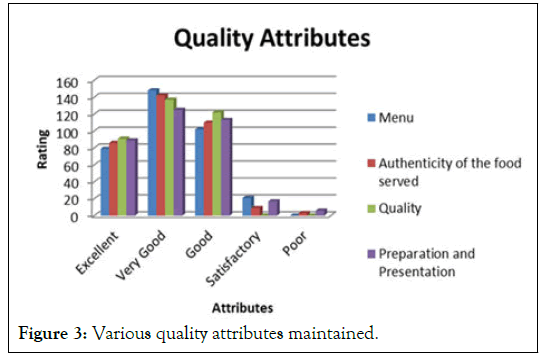
Figure 3: Various quality attributes maintained.
Value for money
By examining the feedback given by the guest, we can conclude that the pricing of the food is appropriate. Most of the customers felt that the money they were paying for the dishes was adequate as the restaurant was maintaining the quality standards of the food being served (Table 4 and Figure 4) [12].
| Criteria | Excellent | Very good | Good | Satisfactory | Poor |
|---|---|---|---|---|---|
| Value for money | 48 | 99 | 152 | 43 | 8 |
| Percentage (%) | 13.71 | 28.28 | 43.42 | 12.29 | 2.29 |
Table 4: Value for money paid for the food and hospitality provided.
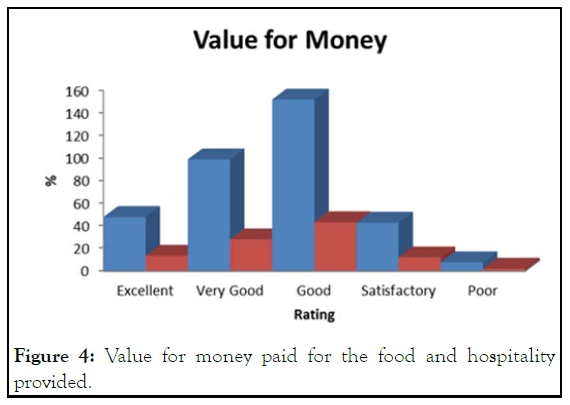
Figure 4: Value for money paid for the food and hospitality provided.
Service review
The questionnaire included feedback pertaining to service offered by the restaurants which covered the following aspects waiting intervals, hospitality, professionalism of the waiter, attentiveness and hygiene practices of the working professionals. The service provided was quick which means the waiting interval was shorter also there was a good number of working professionals in the restaurant which made sure that every table had a waiter waiting on the guest. It was also observed that the staff was quite happy with the management and the system in place which created a positive working atmosphere among the staff which in turn was reflected in their service. Hygiene was maintained by the staff; they wore a clean and neat uniform and were well groomed. The washrooms were provided on the outside premises, away from the kitchen and dining area. The feedback showed that the customers felt staff were very friendly and polite and ensured promptness in their service this was one of the factors that made the guests visit the restaurant often (Table 5 and Figure 5).
| Criteria | Excellent | Very good | Good | Satisfactory | Poor |
|---|---|---|---|---|---|
| Waiting intervals | 111 | 163 | 76 | 0 | 0 |
| Hospitality and professionalism | 109 | 157 | 84 | 0 | 0 |
| Attentiveness | 116 | 148 | 86 | 0 | 0 |
| Hygiene of the working professionals | 101 | 152 | 97 | 0 | 0 |
Table 5: Service review.
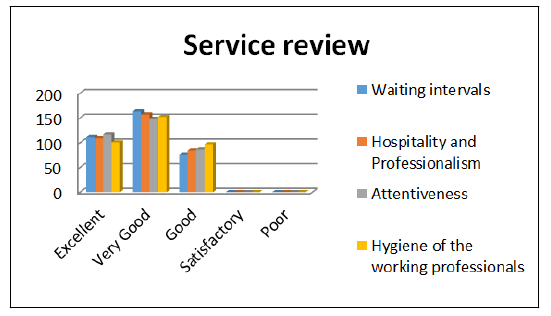
Figure 5: Service review.
Review on ambience
The decor of the restaurant is aesthetic and appealing. Seating arrangements were comfortable for people to consume food in a proper posture. The lighting was appropriate, with the lightning tone to be warm, welcoming and mood enhancing. Food is served in typical plates, bowls and glasses and also serving utensils like handi made from steel, copper and brass are used (Table 6 and Figure 6) [13].
| Criteria | Excellent | Very good | Good | Satisfactory | Poor |
|---|---|---|---|---|---|
| Restaurant design and layout | 81 | 137 | 119 | 13 | 0 |
| Cleanliness | 96 | 168 | 86 | 0 | 0 |
| Seating arrangement | 64 | 114 | 143 | 23 | 6 |
| Lighting | 77 | 159 | 109 | 5 | 0 |
Table 6: Ambience review
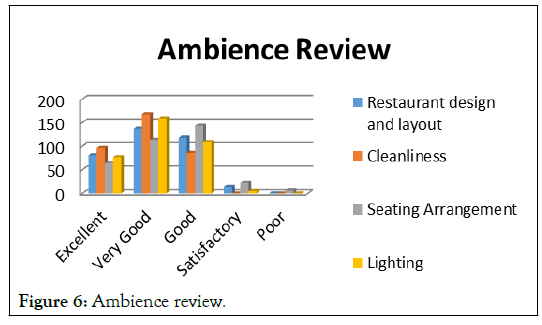
Figure 6: Ambience review.
The Table 7 represents the percentage of tourists purchasing Mangaluru local authentic as souvenirs 66% of the respondents buy local food whereas 34% of the respondents do not buy local food as a souvenir (Table 7 and Figure 7).
| S. No. | Variables | Frequency | Percentage |
|---|---|---|---|
| 1 | Yes | 231 | 66% |
| 2 | No | 119 | 34% |
Table 7: Frequency in respondents ordering authentic Tuluva cuisine at the restaurant.
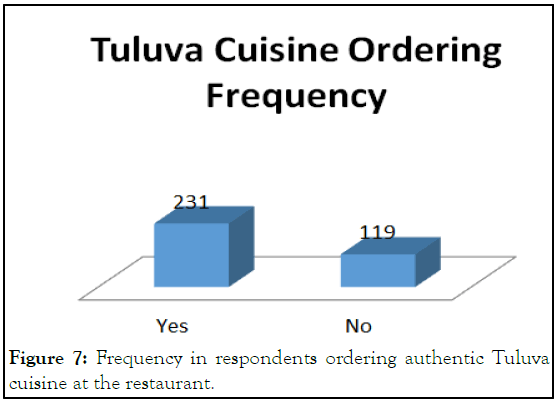
Figure 7: Frequency in respondents ordering authentic Tuluva cuisine at the restaurant.
Overall rating
As per the feedback, the guest found the overall experience was good. They were very happy and satisfied with the food and also the other facilities provided by the restaurant (Table 8 and Figure 8) [14,15].
| Criteria | Excellent | Very good | Good | Satisfactory | Poor |
|---|---|---|---|---|---|
| Overall experience | 72 | 139 | 101 | 27 | 11 |
| Percentage (%) | 20.57 | 39.71 | 28.85 | 7.71 | 3.14 |
Table 8: Overall rating.
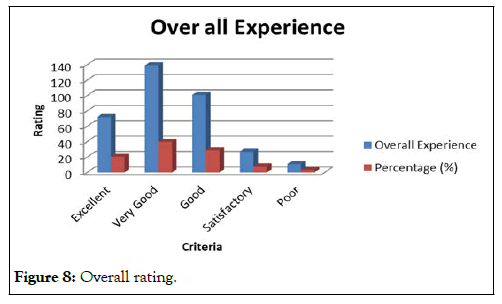
Figure 8: Overall rating.
• Studies should be conducted on the local foods available to learn about their health benefits.
• To encourage and support existing restaurants, to strengthen and increase the acceptance of the Tuluva cuisine.
• Tuluva cuisine must be linked to the tourism aspect which will lead to the increased popularity of the cuisine not only at the local level but also nationwide and thereafter worldwide.
• Food service establishments must be encouraged to feature authentic Tuluva cuisine.
• Organize food festivals and events to feature Tuluva cuisine.
• Various colleges within the district offering Hotel management and hospitality courses must take initiative to promote the Tuluva cuisine and its importance among people through various activities.
From the study, it is evident that Tuluva cuisine has flourished among the localities and is very well accepted among people of various age groups and this can be confirmed by the frequency of people returning to the restaurant. The study also showed that people preferred authentic Tuluva cuisine over other dishes offered by the restaurant. It also confirmed that there was no compromise made with the quality of food being served, at the same time, met the hospitality expectations of the customers.
Furthermore, the findings from the survey indicate that convenience, service, price, ambiance, staff and restaurant layout are all factors that bring customers in, but that satisfying customer needs in terms of the quality and flavor of the food is still the most crucial one. The recipes for these peculiar dishes must be standardized, well documented and therefore made available for future generations.
[Crossref]
Citation: Dsouza CS, John J (2023) A Study on the Acceptance of Traditional Tuluva Cuisine in Mangalore. J Hotel Bus Manag. 12:043.
Received: 30-Mar-2023, Manuscript No. JHBM-23-24156; Editor assigned: 04-Apr-2023, Pre QC No. JHBM-23-24156(PQ); Reviewed: 18-Apr-2023, QC No. JHBM-23-24156; Revised: 02-May-2023, Manuscript No. JHBM-23-24156(R); Published: 30-May-2023 , DOI: 10.35248/2169-0286.23.12.043
Copyright: © 2023 Dsouza CS, et al. This is an open-access article distributed under the terms of the Creative Commons Attribution License, which permits unrestricted use, distribution and reproduction in any medium, provided the original author and source are credited.